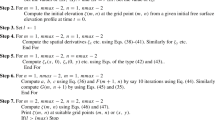Abstract
In this paper, the two-layer viscous shallow-water equations are derived from the three-dimensional Navier-Stokes equations under the hydrostatic assumption. It is noted that the combination of upper and lower equations in the two-layer model produces the classical one-layer equations if the density of each layer is the same. The two-layer equations are approximated by a finite element method which follows our numerical scheme established for the one-layer model in 1978. Finally, it is numerically demonstrated that the interfacial instability generated when the densities are the same can be eliminated by providing a sufficient density difference.
Similar content being viewed by others
References
T. Aoyama, K. Ikeda and A. Takatori, Study on Closing Water Area. Environmental Research Institute Tokyo home page, http://eritokyo.jp/independent/gulf/index.html (in Japanese).
H. Kanayama, A numerical experiment on the wind-driven flow in Mikawa Bay. Proceedings of 15th Symposium on Matrix Analysis Method, JSSC, 1981, 407–412 (in Japanese).
H. Kanayama and T. Ishikawa, A finite element scheme of the two layer viscous shallow water equations. Proceedings of 16th Computational Fluid Dynamics Symposium, D29-1, 2002 (in Japanese).
H. Kanayama and K. Ohtsuka, Finite element analysis on the tidal current and COD distribution in Mikawa Bay. Coastal Engineering in Japan,21 (1978), 157–171.
H. Kanayama and T. Ushijima, On the viscous shallow-water equations I — Derivation and conservation laws—. Memoirs of Numerical Mathematics,8/9 (1981/1982), 39–64.
H. Kanayama and T. Ushijima, On the viscous shallow-water equations II — A linearized system—. Bulletin of University of Electro-Communications,1, No. 2 (1988), 347–355.
H. Kanayama and T. Ushijima, On the viscous shallow-water equations III — A finite element scheme—. Bulletin of University of Electro-Communications,2, No. 1 (1989), 47–62.
Y. Kyozuka, K. Furusho and Y. Kimura, A numerical simulation of water flow by opening the floodgate of embankment in Isahaya Bay. Engineering Sciences Reports, Kyushu University,23, No. 2 (2002), 207–215 (in Japanese).
K. Murakami, Calculations of vertical circulation in stratified waters by 2-level and 2-layer models. Proceedings of Coastal Engineering, JSCE,36, (1989), 204–208 (in Japanese).
T. Sawaragi (ed.), New Coastal Engineering in Global Environment. Fuji Technosystem Co., 2002, 89–96 (in Japanese).
M. Tabata, A finite element approximation corresponding to the upwind finite differencing. Memoirs of Numerical Mathematics,4, (1977), 47–63.
Author information
Authors and Affiliations
Corresponding author
About this article
Cite this article
Kanayama, H., Dan, H. A finite element scheme for two-layer viscous shallow-water equations. Japan J. Indust. Appl. Math. 23, 163 (2006). https://doi.org/10.1007/BF03167549
Received:
Revised:
DOI: https://doi.org/10.1007/BF03167549




